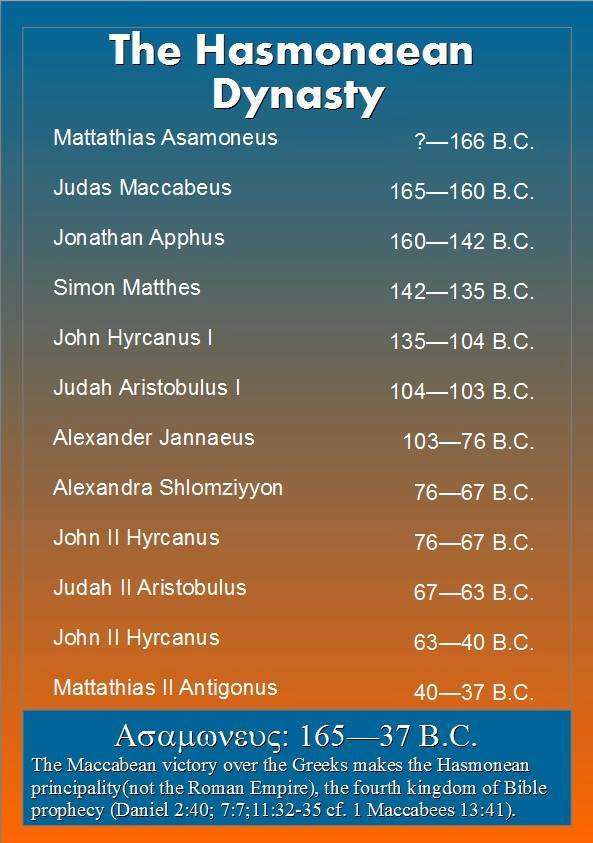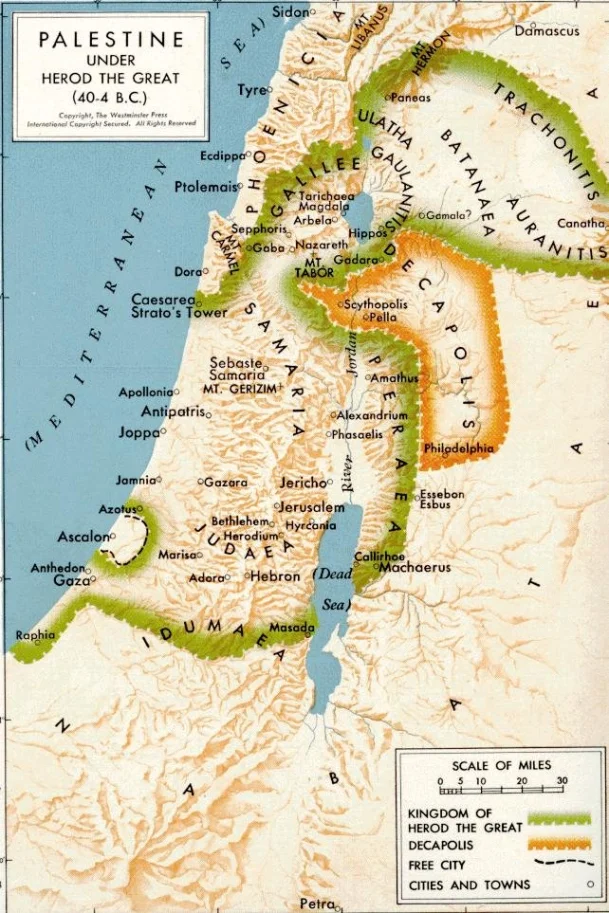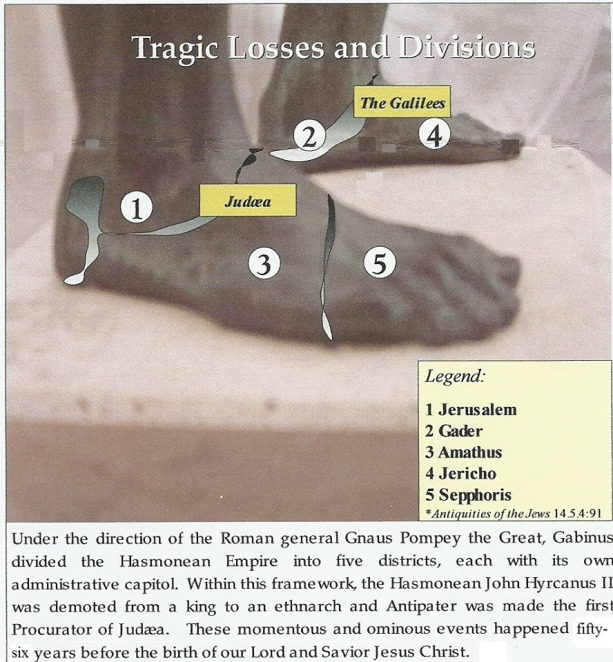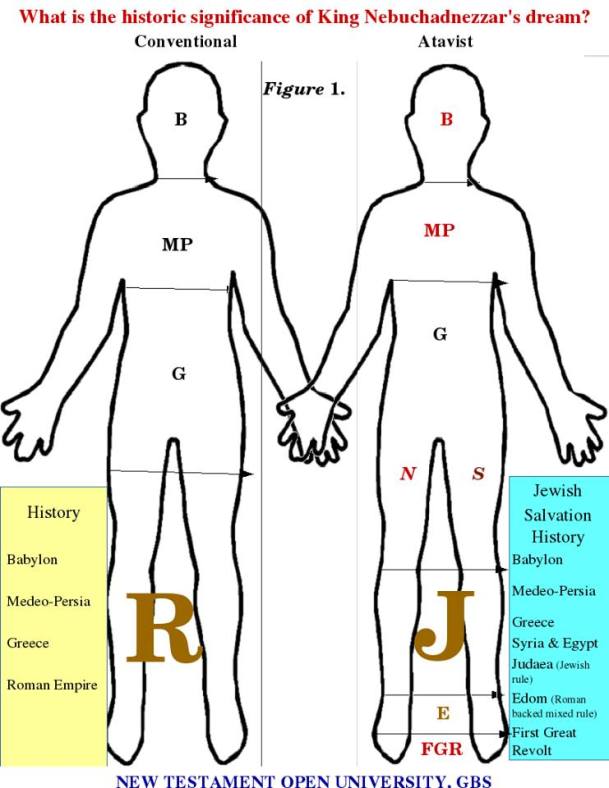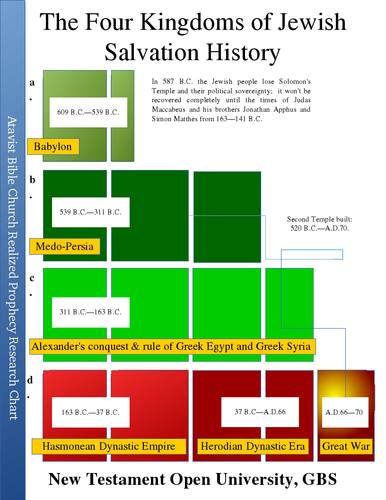This post continues the series, “The Beast of Revelation Was Zealot-Led Israel.” The introduction and outline to this series can be seen here.
In the previous post, “Daniel 2: Babylon, Medo-Persia, and Greece/Macedonia,” we began to look at Daniel 2 and the image in Nebuchadnezzar’s dream that represented four kingdoms. We saw that the first three kingdoms are clearly identified in the book of Daniel as Babylon, Medo-Persia, and Greece. In this post we will examine the transition from the third kingdom to the fourth kingdom, which is also the fourth beast of Daniel 7 and “the beast” of Revelation.
“In the latter time” of the third kingdom, the infamous Antiochus Epiphanes rose to power, fulfilling Daniel 8:23-26. Daniel was told that he would be broken (verse 25) and this took place in 164 BC. It’s commonly taught that at this point in history, dominion over Israel passed from the hands of Greece to Rome. However, no such transfer actually took place. In fact, neither Daniel 8 nor Daniel 11 mention (or even allude to) Rome’s takeover of Greece. Why is this significant?
As we’ve seen, the transition from the first kingdom (Babylon) to the second kingdom (Medo-Persia) is described in Daniel 5:30-31. The transition from the second kingdom to the third kingdom (Greece) is described in Daniel 8:1-7. Daniel is only shown the destiny of the Greek kingdom up until the breaking of Antiochus Epiphanes (Daniel 8:25), and Daniel 11:32 likewise depicts an uprising against Antiochus Epiphanes. The perfect time to predict Rome’s conquest of Greece would have been in either Daniel 8 or Daniel 11, since Macedonia was established as a province of the Roman republic in 146 BC, but Daniel didn’t do that.
If Rome was the fourth kingdom foreseen in Daniel 2:40-43 and Daniel 7:7, then the book of Daniel never described the transition from the third kingdom to the fourth kingdom as it did for the previous transitions. What if the description of the Maccabees in Daniel 11:32-35 has everything to do with the transition from the third kingdom to the fourth kingdom? Israel was about to be under no one’s dominion at all.
Kingdom #3 (Bronze / Belly and Thighs) to Kingdom #4 (Iron and Iron-Clay / Legs and Feet)
II Maccabees 5:2-4 describes a prolonged supernatural event seen by “people all over Jerusalem” in 164 BC:
“For nearly forty days people all over Jerusalem saw visions of cavalry troops in gold armor charging across the sky. The riders were armed with spears and their swords were drawn. They were lined up in battle against one another, attacking and counterattacking. Shields were clashing, there was a rain of spears, and arrows flew through the air. All the different kinds of armor and the gold bridles on the horses flashed in the sunlight. Everyone in the city prayed that these visions might be a good sign.”
When the same vision was seen nearly 230 years later (Wars 6.5.3), it was not a good sign for Jerusalem. This time it was, though. The Jewish Virtual Library continues its overview of Israel’s history by discussing Israel’s transition from dominance by the Greeks/Macedonians to full independence in 142 BC (see the previous post for the first part of this overview):
The Jews Regain Their Independence
It took more than two decades of fighting before the Maccabees forced the Seleucids to retreat from the Land of Israel. By this time Antiochus had died and his successor agreed to the Jews’ demand for independence. In the year 142 BCE, after more than 500 years of subjugation, the Jews were again masters of their own fate.
When Mattathias died, the revolt was led by his son Judas, or Judah Maccabee, as he is often called. By the end of the war, Simon was the only one of the five sons of Mattathias to survive and he ushered in an 80-year period of Jewish independence in Judea, as the Land of Israel was now called. The kingdom regained boundaries not far short of Solomon’s realm and Jewish life flourished.
The Hasmoneans claimed not only the throne of Judah, but also the post of High Priest. This assertion of religious authority conflicted with the tradition of the priests coming from the descendants of Moses’ brother Aaron and the tribe of Levi.
Daniel 11:31-32 summarizes the actions of Antiochus Epiphanes and the victory of the Maccabees in this way:
“And forces shall be mustered by him, and they shall defile the sanctuary fortress; then they shall take away the daily sacrifices, and place there the abomination of desolation. Those who do wickedly against the covenant he shall corrupt with flattery; but the people who know their God shall be strong, and carry out great exploits.”
This is clearly a reference to the monotheistic Jews and not the polytheistic Romans. In greater detail, the victory of the Maccabees was recorded in I Maccabees 13:41-42:
“In the year one hundred and seventy [of the Seleucid Empire] the yoke of the Gentiles was taken off from Israel. And the people of Israel began to write in the instruments, and public records, ‘The first year under Simon the high priest, the great captain and prince of the Jews.’”
In Wars of the Jews 1.2.2 Josephus described how Simeon (or Simon) Maccabee achieved a series of victories over Antiochus Epiphanes:
“Simeon managed the public affairs after a courageous manner, and took Gazara, and Joppa, and Jamnia, which were cities in the neighborhood. He also got the garrison under, and demolished the citadel… he also laid a great many men in ambush in many places of the mountains, and was superior in all his attacks upon them. And when he had been conqueror after so glorious a manner, he was made high priest, and also freed the Jews from the dominion of the Macedonians, after a hundred and seventy years of the empire [of Seleucus].”
Wikipedia says this about the Maccabees and the dynasty they founded:
“The Maccabees… were the leaders of a Jewish rebel army that took control of Judea, which at the time had been a province of the Seleucid Empire. They founded the Hasmonean dynasty, which ruled from 164 BCE to 63 BCE. They reasserted the Jewish religion, partly by forced conversion, expanded the boundaries of Judea by conquest and reduced the influence of Hellenism and Hellenistic Judaism.”
This was the transition:
*from bronze to iron
*from the belly and thighs to the legs and feet (the final stage of the image)
*from the third kingdom to the fourth kingdom
Contrary to my previous assumptions, dominion over Israel did not pass from the Greek Empire to the Roman Empire. In fact, when Israel defeated Macedonia, the Republic of Rome expressed its congratulations and an alliance was confirmed between Rome and Israel:
“And all the land of Juda was at rest all the days of Simon, and he sought the good of his nation: and his power, and his glory pleased them well all his days. And with all his glory he took Joppe for a haven, and made an entrance to the isles of the sea. And he enlarged the bounds of his nation, and made himself master of the country… the fame of his glory was renowned even to the end of the earth. He made peace in the land, and Israel rejoiced with great joy. And every man sat under his vine, and under his fig tree: and there was none to make them afraid…
And it was heard at Rome, and as far as Sparta, that Jonathan was dead: and they were very sorry. But when they heard that Simon his brother was made high priest in his place, and was possessed of all the country, and the cities therein: They wrote to him in tables of brass, to renew the friendship and alliance which they had made with Judas, and with Jonathan his brethren… And after this Simon sent Numenius to Rome, with a great shield of gold the weight of a thousand pounds, to confirm the league with them” (I Maccabees 14:4-24).
The fourth kingdom of Nebuchadnezzar’s dream wasn’t Rome. It was Israel – “as strong as iron” (Daniel 2:33, 40) at first, and “partly strong and partly fragile” (Daniel 2:33, 41-43) later. It’s important to keep in mind that the timeline of Nebuchadnezzar’s image would only extend until the stone would crush its feet (Daniel 2:34, 44; Matthew 21:44). Greece/Macedonia was the belly and thighs of the image, and the fourth kingdom was the legs and the feet, the final part of that timeline. It was Israel, not Rome, that was later crushed by the stone. Consider how proportional these body parts are to the time periods represented in this scenario:
|
BODY PARTS |
KINGDOM |
TIME PERIOD |
| Head | Babylon | 605 BC – 539 BC (66 years) |
| Chest and arms | Medo-Persia | 539 BC – 329 BC (210 years) |
| Belly and thighs | Greece/Macedonia | 329 BC – 164 BC (165 years) |
| Legs and feet | Hasmonean/Israel | 164 BC – AD 70 (234 years) |
How would the last row above look if Rome was the fourth kingdom? Would the body parts in Nebuchadnezzar’s statue remain proportional, or would a pair of stilts be required?
| Legs and feet | Rome | 146 BC* – AD 476 (622 years) |
*Rome’s “Late Republic” period dates from its defeat over Corinth in 146 BC, which ended the Macedonian kingdom. The Roman Empire began in 27 BC. If that was the beginning of the legs and feet, it would represent a time period of 503 years and there would be a gap of more than 100 years between the third and fourth kingdoms in Nebuchadnezzar’s dream.
This chart shows a list of significant events which took place during the time of Israel’s Hasmonean (Maccabean) Dynasty (164 BC – 37 BC) and the Herodian Dynasty (37 BC –>) that followed:
| Year | Event | Timing in Relation to Israel’s Independence |
| 164 BC |
Israel, led by the Maccabees, defeats Antiochus Epiphanes |
22 years prior |
| 142 BC |
Israel becomes fully independent from Macedonia/Greece |
At this time |
| 63 BC |
Pompey the Great, a Roman statesman, intervenes in the Judean civil war between Hyrcanus and Aristobulus, the two sons of Queen Alexandra Salome. The province of Syria was created at this time, and Judea was incorporated into the Roman republic. Judea remained autonomous, but lost some of its land, including parts of Samaria and Idumea. Other cities that had been under Judea became autonomous as well and formed the Decapolis. One of those cities was Pella. “The people of the Decapolis cities welcomed Pompey as a liberator from the Jewish Hasmonean kingdom that had ruled much of the area” (Wikipedia). Aristobulus was taken to Rome, but Hyrcanus was reinstated as the High Priest and Antipater the Idumean became the chief minister of Judea. Antipater was pro-Roman and even rescued Julius Caesar in Alexandria, for which he was rewarded. |
79 years later |
| 47 BC |
Hyrcanus was recognized by Rome as the ethnarch (ruler) of Judea, and Antipater was recognized as the first Roman Procurator. |
95 years later |
| 40 – 37 BC |
The Roman Senate appointed Herod the Great as “King of Judea” in 40 BC. However, at that time the Parthians (modern NE Iran) conquered the Levant, including the land of Israel. The Jews thought a new era of independence had come. It took Rome three years to defeat the Parthians. |
102 – 105 years later |
| 37 BC |
Hasmonean rule ended when Herod the Great captured Jerusalem and unseated Antigonus II Mattathias. Antipater the Idumean was Herod’s father. Herod married a Hasmonean princess named Mariamne. The Herodian dynasty began in Judea. |
105 years later |
| 27 BC | The Roman empire began. | 115 years later |
| 6 AD |
The Jewish Zealot movement was founded by Judas of Galilee. |
148 years later |
Source: Mark Mountjoy, New Testament Open University; July 28, 2016
Is the Herodian dynasty spoken of in Daniel? In a 2005 article, Bryan T. Huie explains how Daniel 11:36-45 moves on from speaking of Antiochus Epiphanes and the Hasmoneans who conquered him, and goes on to speak of Herod the Great and Octavius (Augustus Caesar):
“In this verse [Daniel 11:36], the king being spoken of changes. Starting in verse 21, Antiochus IV Epiphanes was the referenced king. Verses 32 through 35 prophesy his defeat by the Maccabees (the Hasmoneans) and encompass the subsequent fall of their dynasty. But the context shows that the remaining verses in this chapter cannot apply to Antiochus IV… Both secular history and the New Testament record the acts of a king who appeared on the scene in Israel at the end of the Hasmonean period. As we shall see, this king fulfilled every prophetic description given in verses 36 through 39. That king was Herod the Great. In verse 36, the one spoken of is not identified as either the king of the North or the king of the South, but simply as ‘the king.’ Herod was seated as king on the throne of Israel when Messiah Yeshua was born. He is called ‘the king’ in the Gospels (Matt. 2:1, 3, 9; Luke 1:5)…”
Bryan’s full commentary on Daniel 11:36-45, and how it was fulfilled in the lives of Herod and Octavius (later Augustus Caesar), is worth examining. It compares well with Philip Mauro’s conclusions in his 1922 book, “The Seventy Weeks and the Great Tribulation” (Chapter 9).
Herod the Great was from Idumea, and was of Edomite lineage. Between 47 – 40 BC he served as the Governor and then the Tetrarch of Galilee. After he convinced Rome of his pro-Roman loyalty, the Roman Senate appointed him as the king of Judea in 40 BC (Josephus, Wars 1.14.4). After a three year war he wrestled the control of this position from the last Hasmonean ruler, Mattathias II Antigonus. Herod began the Herodian dynasty by ruling over Judea from 37 BC to 4 BC.
Source: 40 Maps That Explain the Roman Empire (#24)
Mark Mountjoy remarks in New Testament Open University (August 23, 2015),
“It was at that point that Herod the Great, the son-in-law of the Hasmoneans, turned the Hasmonean Empire into the Herodean Kingdom of Edom–or the feet of iron and clay. So when the fourth kingdom changes from pure iron to iron and clay, and when the rulers of the fourth kingdom are no longer of Jewish stock but of Edomite lineage, and when the gains of the Maccabees were divided up and ruled over by the sons and grandsons (and a daughter and grandaughter) of Herod the Great, that could only mean the end of the intact statue was drawing very near. Moreover, John the Baptist and Jesus and all the first Christians were living at that stage of biblical history. This is why John the Baptist believed the Kingdom of God (the fifth kingdom of Daniel 2 and 7) was near (Matthew 3:2). And this is why Jesus our Lord believed the Kingdom of God (the same fifth kingdom of Daniel 2 and 7) was near (Matthew 4:17 and 10:7). Jesus did not believe or teach that it was coming immediately (Luke 19:11), but he did teach that it would come before all those people who lived at that time had died (Matthew 10:23; 16:27-28; Matthew 24:34; John 21:21-23).”
The Judean Kingdom Divided (Daniel 2:41)
Daniel 2:41 says this about the final stage of Nebuchadnezzar’s image: “Whereas you saw the feet and toes, partly of potter’s clay and partly of iron, the kingdom shall be divided; yet the strength of the iron shall be in it, just as you saw the iron mixed with ceramic clay.”
Almost a decade after the invasion of Pompey the Great in 63 BC, a major division took place in 57-55 BC when the proconsul of Syria, Aulus Gabinius, divided the Hasmonean kingdom into five parts. As Josephus records in Antiquities 14.5.4, when Gabinius “had ordained five councils, he distributed the nation into the same number of parts. So these councils governed the people; the first was at Jerusalem, the second at Gadara, the third at Amathus, the fourth at Jericho, and the fifth at Sepphoris in Galilee. So the Jews were now freed from monarchic authority, and were governed by an aristocracy.”
Source: Mark Mountjoy, New Testament Open University; August 13, 2015
According to Wikipedia’s entry on the Herodian Dynasty, when Herod died in 4 BC his kingdom also “was divided between his sons as a Tetrarchy, which lasted for about 10 years. Most of those kingdoms, including Judea proper, were incorporated into Judaea Province in 6 CE.” This was the same year that the Jewish Zealot movement was founded by Judas of Galilee.
They Will Not Adhere to One Another (Daniel 2:43)
Daniel 2:43 says that the iron and the clay would not mix well:
“As you saw iron mixed with ceramic clay, they will mingle with the seed of men; but they will not adhere to one another, just as iron does not mix with clay.”
The Jewish Virtual Library discusses how Judea was unique among the provinces of Rome because of its frequent revolts and unwillingness to integrate:
“Judea differed from the other provinces in the east of the Roman Empire in that it never resigned itself to Roman rule and did not willingly become integrated into the Imperial system. From the beginning of the Roman conquest its history was one of bitter struggle accompanied by revolts against the Imperial power. Although there were revolts in the Western parts of the Empire too (in Britain and Gaul and by the Batavi), these were not as frequent and they generally occurred in the early stages of Roman occupation and on the frontiers of the Empire. In Judea, however, a province that lay in the heart of a vital area, between Syria and Egypt, relations with the Roman authorities were in a state of almost continuous tension from the period of Pompey and Gabinius until after the Bar Kokhba War.”
Source: Mark Mountjoy, New Testament Open University; August 15, 2016
In 70 AD the Roman general Titus attested to the semi-independence of Israel during the preceding period. He addressed the Jewish Zealot leaders and gave a speech which painted a picture of the privileges, exceptions, and advantages that Israel enjoyed while under the jurisdiction of Rome from 63 BC to 66 AD (a period of 129 years):
“You have been the men that have never left off rebelling since Pompey first conquered you, and have, since that time, made open war with the Romans… It can therefore be nothing certainly but the kindness of us Romans which hath excited you against us; who, in the first place, have given you this land to possess; and, in the next place, have set over you kings of your own nation; and, in the third place, have preserved the laws of your forefathers to you, and have withal permitted you to live, either by yourselves, or among others, as it should please you: and, what is our chief favor of all we have given you leave to gather up that tribute which is paid to God with such other gifts that are dedicated to him; nor have we called those that carried these donations to account, nor prohibited them; till at length you became richer than we ourselves, even when you were our enemies; and you made preparations for war against us with our own money; nay, after all, when you were in the enjoyment of all these advantages, you turned your too great plenty against those that gave it you, and, like merciless serpents, have thrown out your poison against those that treated you kindly” (Josephus, Wars 6.6.2).
The figure below compares the conventional way of viewing Nebuchadnezzar’s dream with what Mark Mountjoy calls the Atavist view (B = Babylon, MP = Medo-Persia, G = Greece, N & S = North & South, J = Judea, and E = Edom):
Source: Mark Mountjoy, New Testament Open University; September 1, 2015
Source: Mark Mountjoy, New Testament Open University; July 28, 2016
Kingdom #4 (Iron & Iron-Clay/Legs & Feet) to the Everlasting Kingdom (Mountain of God)
The transition from the fourth kingdom to the everlasting kingdom of the saints was predicted by Jesus in Matthew 21:42-44. In Matthew 21, we see that the kingdom was going to be taken away from the Chief Priests and the Pharisees. If Rome was the fourth kingdom of Nebuchadnezzar’s dream and the kingdom was in the hands of the Roman Empire, as is so often taught, then how was the kingdom going to be taken away from the leaders of Israel? Jesus uses the language of Daniel here:
“Therefore I say to you, [A] the kingdom of God will be taken from you and [B] given to a nation bearing the fruits of it. And whoever falls on [C] this stone will be broken; but on whomever it falls, it will [D] grind him to powder. Now when the chief priests and Pharisees heard His parables, they perceived that [E] He was speaking of them” (Matthew 21:43-45).
“You watched while [C] a stone was cut out without hands, which [D] struck the image on its feet of iron and clay, and broke them in pieces. Then the iron, the clay, the bronze, the silver, and the gold were [D] crushed together, and became like chaff from the summer threshing floors; the wind carried them away so that no trace of them was found. And [C] the stone that struck the image became a great mountain and filled the whole earth… And in the days of these kings the God of heaven will set up a kingdom which shall never be destroyed … The fourth beast shall be [E] a fourth kingdom on earth, which shall be different from all other kingdoms, and shall devour the whole earth, trample it and break it in pieces… Then [A] the kingdom and dominion and the greatness of the kingdoms under the whole heaven, shall be [B] given to the people, the saints of the Most High. His kingdom is an everlasting kingdom…” (Daniel 2:34-35, 44; 7:23, 27).
Perhaps a similar picture of this transfer is also seen in Matthew 8:10-12, in the words that Jesus spoke to the centurion:
“Assuredly, I say to you, I have not found such great faith, not even in Israel! And I say to you that many will come from east and west, and sit down with Abraham, Isaac, and Jacob in the kingdom of heaven. But the sons of the kingdom will be cast out into outer darkness. There will be weeping and gnashing of teeth.”
Why did Jesus refer to the people of Israel as “the sons of the kingdom”? Was it merely because of the common assumption that the people of Israel were the rightful heirs of the kingdom? Or was Jesus also referring to the fact that the fourth kingdom of Nebuchadnezzar’s vision was in the hands of Israel? About 40 years later, of course, it would no longer be in their hands. It would be in the hands of the saints.
No Place Was Found for Them
Mark Mountjoy points out that a certain expression in Daniel 2:35 was very likely significant for Israel in a way that it couldn’t possibly have been for Rome. That expression is this: “…and the wind carried them away, that no place was found for them.” Although a few translations say “no trace of them was found,” most say that “no place was found for them.” Why did this expression hold significance for Israel? Mark explains:
“[If] the Spirit of God had the termination of Temple history in mind, it would mean the Jewish people were unable to obtain what they sought because Christ in his power and prerogative as God withheld it from them. Proof of this term ‘place’ being intended to speak of the Temple may be seen in what was said by Caiaphas in his emergency meeting with the Sanhedrim recorded in John 11:48. There it reads,
‘Then gathered the chief priests and the Pharisees a council, and said, “What do we do? For this man does many miracles… If we let him thus alone, all men will believe on him, and the Romans shall come and take away our place and nation.”’”
Caiaphas’ concern was with both the nation and the temple, just as Daniel 9:26 predicted that “the city and the temple” would be destroyed. Similarly, Acts 6:9-14 describes a dispute that arose against Stephen from the Synagogue of the Freedman. Stephen was brought before the religious council in Jerusalem and false witnesses said:
“This man does not cease to speak blasphemous words against this holy place and the law; for we have heard him say that this Jesus of Nazareth will destroy this place and change the customs which Moses delivered to us” (verses 13-14).
In these two instances, it’s clear that the “place” they spoke of was the temple in Jerusalem. This is confirmed again in Acts 21:26-28, when Jews from Asia attacked and accused Paul in the temple, saying,
“Men of Israel, help! This is the man who teaches all men everywhere against the people, the law, and this place; and furthermore he also brought Greeks into the temple and has defiled this holy place” (verse 28).
The same expression found in Daniel 2:35 is also found in Revelation 20:11. There, in speaking of the old heaven and the earth passing away, it’s said that “there was found no place for them.” In the writings of Josephus, the temple was said to represent heaven and earth (Wars 5.5.4). Likewise, heaven and earth represented Israel and the temple in both the Old Testament and the New Testament (e.g. Leviticus 26:19; Deuteronomy 32:1; Isaiah 1:1-2, 51:16; Matthew 5:18, 24:35; Hebrews 12:25-28; II Peter 3:10).
The old covenant was obsolete and ready to vanish away in the first century (Hebrews 8:13). There was no place found for the temple because God chose to make His tabernacle with His people in New Jerusalem (Revelation 21:2-3). Thus, the prophetic declaration in Daniel 2:35 appears to have been significant for Israel in a way that it couldn’t have been for Rome.
The next post will begin to examine Daniel’s own vision of four beasts in Daniel 7, in which he is given key details about the fourth beast – the beast of Revelation.
———————————-
All of the posts in this series can be found at this page.

